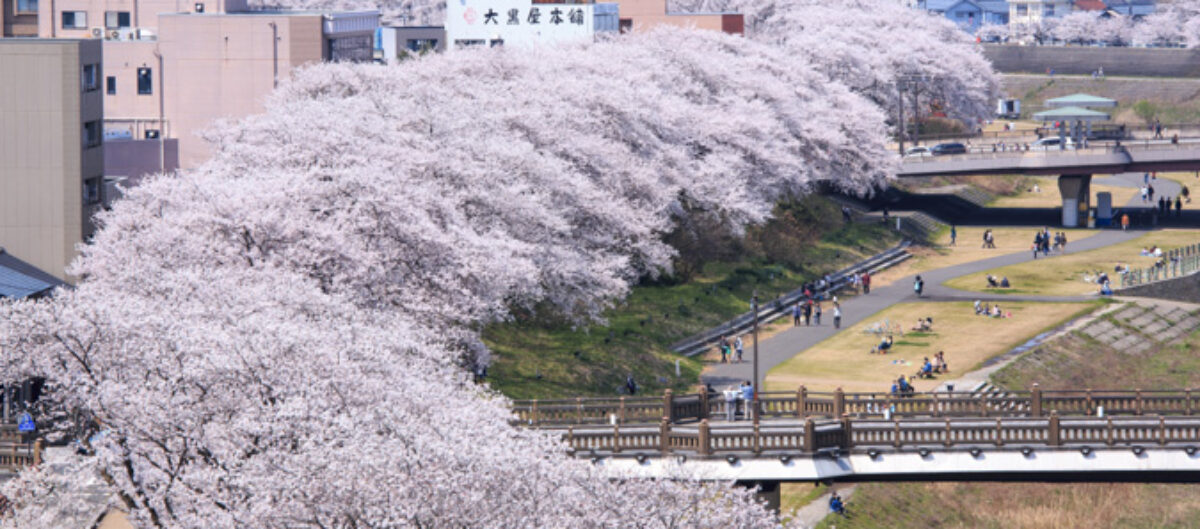
September/17/2022
Kehi Jingu Shrine (氣比神宮), which is in Tsuruga, is one of the best-known shrines in Fukui Prefecture. It has one of Japan’s three greatest wooden torii gates and is a symbol of Tsuruga.

The shrine was built in 702. In the Middle Ages it was destroyed in a battle, but in 1614 it was restored. The main shrine was a designated national treasure until World War Two, but it was devastated in the war. After the war it was rebuilt.
Kehi Jingu Shrine is the ichinomiya of Echizen. (The northern part of Fukui used to be called Echizen Province, and ichinomiya is a Japanese historical term referring to the Shinto shrines with the highest rank in a province. There are only two ichinomiya in Fukui.)
If you don’t know anything about Shinto shrines, be sure to see my previous entry. (Fukui Shrine and what’s a Shinto shrine?)
There are three highlights at Kehi Jingu Shrine that are great for sightseers:
- The torii gate
- The chomeisui (water of long life)
- The statue of Matsuo Basho

A torii gate is a gateway from the mundane to the sacred world, and it’s the symbol of a Shinto shrine. The gate at Kehi Jingu Shrine has high cultural and architectural value, and because of this it’s considered one of Japan’s three greatest wooden torii gates, along with Kasuga-Taisha Shrine in Nara and Itsukushima Shrine in Hiroshima. (Kasuga-Taisha Shrine and Itsukushima Shrine are registered as World Heritage Sites.)
The gate was built in 810. In the 14th century it was destroyed by a storm, and in 1645 it was restored. It’s been about 380 years since the restoration, and the gate is now nationally designated as an Important Cultural Property.
The torii gate is about 11 meters high and about 7.5 meters wide. It’s vermilion and gives an impression of holiness and beauty. The top part of the torii (which curves toward the sky) has a dignified look.

There’s a stone statue of a turtle that lies 30 meters from the torii gate, and water called chomeisui comes from its mouth. It’s spring water that’s been coming out continuously since 702, for more than 1,300 years. One of the gods at Kehi Jingu Shrine (Takeuchi no Sukune no Mikoto, 武内宿禰命) lived a long life (more than 250 years), and that’s why the water was named chomeisui (water of long life). The water is widely known, and a lot of people go to the shrine to drink it. However, since the coronavirus pandemic began, people have been encouraged to just touch the water instead. If you touch it you might live a long time.

The shrine is also known as a place where Matsuo Basho once went, and because of this there’s a statue of Basho there. Basho (1644–1694) was one of the greatest haiku poets in Japan. (Haiku is a type of short-form poem that was developed in Japan.) He went to the shrine and wrote about it as follows:

On the fourteenth I found lodgings at the port of Tsuruga. The moon was particularly bright that night. I asked the innkeeper, “Will it be like this tomorrow night for the full moon?” He replied, “It’s hard to guess from one night to the next in Koshiji whether it’ll be rainy or fair.”
After accepting the sake pressed on me by the innkeeper, I went to the Kei Shrine(Kehi Jingu Shrine) for night worship. The shrine contains the tomb of the Emperor Chūai. The precincts of the shrine have sanctity, and in the moonlight that filtered through the pines the white sand before the shrine looked as though it were covered with frost. The innkeeper told me, “Once, long ago, the second Pilgrim-Priest asked some great favor of the gods. He himself cut grass and carried earth and stones to dry up the muddy grounds of the shrine. He made it easier in this way for all to come and worship. This custom has not died out. Priests still carry fine sand to sprinkle before the shrine, calling it the ‘sand-carrying of the Pilgrim-Priest.’”
How pure the moonlight
On the sand before the shrine
Brought by Pilgrim-Priests.
(Source: The Narrow Road to Oku)(Translated by Donald Keene)

At Kehi Jingu Shrine seven gods are enshrined, and the main one is Izasawake no Mikoto (伊奢沙別命), who is a god of food. The shrine is believed to have the power to bring peace to households, maritime traffic safety, safe childbirth, good health, and long life.

How to pray at the shrine:
- Put some coins (yen) into the offertory box.
- Bow twice.
- Clap your hands twice, then make a wish or offer a prayer.
- Bow once again.
Japanese people pray at shrines when they want to pass difficult examinations, give birth safely, become rich, or become healthy.
Kehi Jingu Shrine, Kehi no Matsubara, and the Port of Humanity Tsuruga Museum are all in Tsuruga. They’re relatively close to one another, so you might want to go to these three spots as soon as you get to Tsuruga. (If you don’t know anything about Kehi no Matsubara or the Port of Humanity Tsuruga Museum, be sure to read my previous entries.)

Kehi Jingu Shrine is one of the best-known shrines in Fukui, and it’s a symbol of Tsuruga. The torii gate there is unique and beautiful, and it’s one of Japan’s three greatest wooden torii gates. The shrine is easily accessible: It takes about 15 minutes to walk there from JR Tsuruga Station. It’s a good place to go.
——Kehi Jingu Shrine Information——
Open: (April to September) 5 a.m.–5 p.m.
(October to March) 6 a.m.–5 p.m.
Admission: Free
Access: A 15-minute walk from JR Tsuruga Station
The official website in Japanese: https://kehijingu.jp/
(References):
「氣比神宮ホームページ」
「福井県の歴史散歩」(編集:福井県の歴史散歩編集委員会)(山川出版社)
「敦賀てくてくまちある記」(敦賀市)
「週刊 神社紀行 氣比神宮 気多大社 若狭彦神社」(学習研究社)
「福井「地理・地名・地図」の謎」(監修:内池久貴)(実業之日本社)
「英文収録 おくのほそ道」(松尾芭蕉、ドナルド・キーン訳)(講談社)
